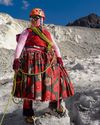
For the past four years, a special government task force in Fiji has been trying to work out how to move the country. The plan it has come up with runs to 130 pages of dense text, interspersed with intricate spider graphs and detailed timelines. The document has an uninspiring title – Standard Operating Procedures for Planned Relocations – but it is the most thorough plan ever devised to tackle one of the most urgent consequences of the climate crisis: how to relocate communities whose homes will soon be, or already are, under water.
The task is huge. Fiji, which lies in the south Pacific, 3,000km east of Australia, has more than 300 islands and a population of just under 1 million. Like most of the Pacific, it is starkly susceptible to the impacts of the climate crisis. Surface temperatures and ocean heat in parts of the southwest Pacific are increasing three times faster than the global average rate. Severe cyclones routinely batter the region. In 2016, Cyclone Winston hit Fiji, killing 44 people and causing $1.4bn of damage, a third of Fiji’s GDP. Since then, Fiji has been hit by a further six cyclones. Five of the 15 countries most at risk from weather-related events are in the Pacific. Fiji is number 14.
What Fiji is attempting to do is unprecedented. For years, politicians and scientists have been talking about the prospect of climate migration. In Fiji, and in much of the Pacific, this migration has already begun. Here, the question is no longer if communities will be forced to move, but how exactly to do it. At present, 42 Fijian villages have been earmarked for potential relocation in the next five to 10 years, owing to the impacts of the climate crisis. Six have already been moved. Every new cyclone or disaster brings with it the risk of yet more villages being added to the list.
هذه القصة مأخوذة من طبعة November 18, 2022 من The Guardian Weekly.
ابدأ النسخة التجريبية المجانية من Magzter GOLD لمدة 7 أيام للوصول إلى آلاف القصص المتميزة المنسقة وأكثر من 9,000 مجلة وصحيفة.
بالفعل مشترك ? تسجيل الدخول
هذه القصة مأخوذة من طبعة November 18, 2022 من The Guardian Weekly.
ابدأ النسخة التجريبية المجانية من Magzter GOLD لمدة 7 أيام للوصول إلى آلاف القصص المتميزة المنسقة وأكثر من 9,000 مجلة وصحيفة.
بالفعل مشترك? تسجيل الدخول

The Saudi football World Cup is an act of violence and disdain
Well, that's that then. In the event there were only two notes of jeopardy around Fifa's extraordinary virtual congress last week to announce the winning mono-bids, the vote without a vote, for the right to host the 2030 and 2034 football World Cups.

AI has made the move into video and it's worryingly plausible
I recently had the opportunity to see a demo of Sora, OpenAI's video generation tool, which was released in the US last Monday, and it was so impressive it made me worried for the future.

With tyrant Assad ousted, Syrians deserve support and hope
Last week, time collapsed. Bashar al-Assad's fall recalled scenes across the region from the start of the Arab spring almost 14 years ago. Suddenly history felt vivid, its memories sharpened. In fact it no longer felt like history.

TV
The Guardian Weekly team reveals our small-screen picks of the year, from the underground vaults of post-apocalyptic Fallout to the mile-high escapism of Rivals

Albums
Murky love stories, nostalgic pop and an in-your-face masterpiece captured our critics' ears in 2024

Film
Visual language, sound, light and rhythm are to the fore in the best movies of the year

Hidden delights Our 24 travel finds of 2024
Guardian travel writers share their discoveries of the year, from Læsø to Lazio

'It's really a disaster' The fight to save lives as gang war consumes capital
Dr James Gana stepped out on to the balcony of his hospital overlooking a city under siege. \"There's a sensation of 'What's next?'. Desperation is definitely present,\" the Médecins Sans Frontières (MSF) medic said, as he stared down at one of scores of camps for displaced Haitians in their country's violence-plagued capital.

Trailblazers The inspiring people we met around the world this year
From an exuberant mountaineer to a woman defiantly facing the guns of war, here are some of the brave individuals who gave us hope in a tumultuous 2024

Votes of confidence
From India to Venezuela and Senegal to the US, more people voted this year than ever before, with over 80 elections across the world. With rising authoritarianism and citizen-led resistance revealing its vulnerabilities and resilience in the face of unprecedented challenges, has democracy reached its breaking or turning point?